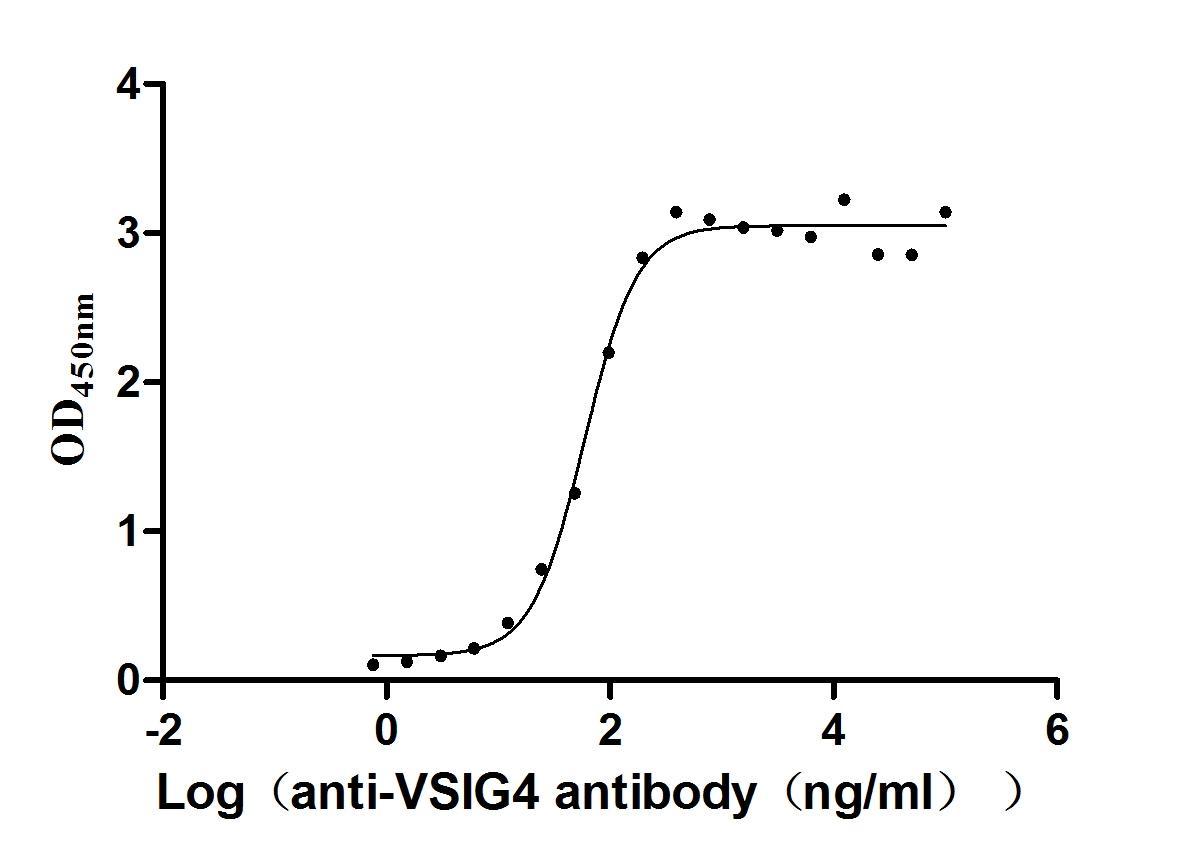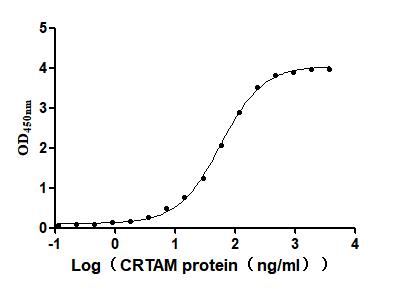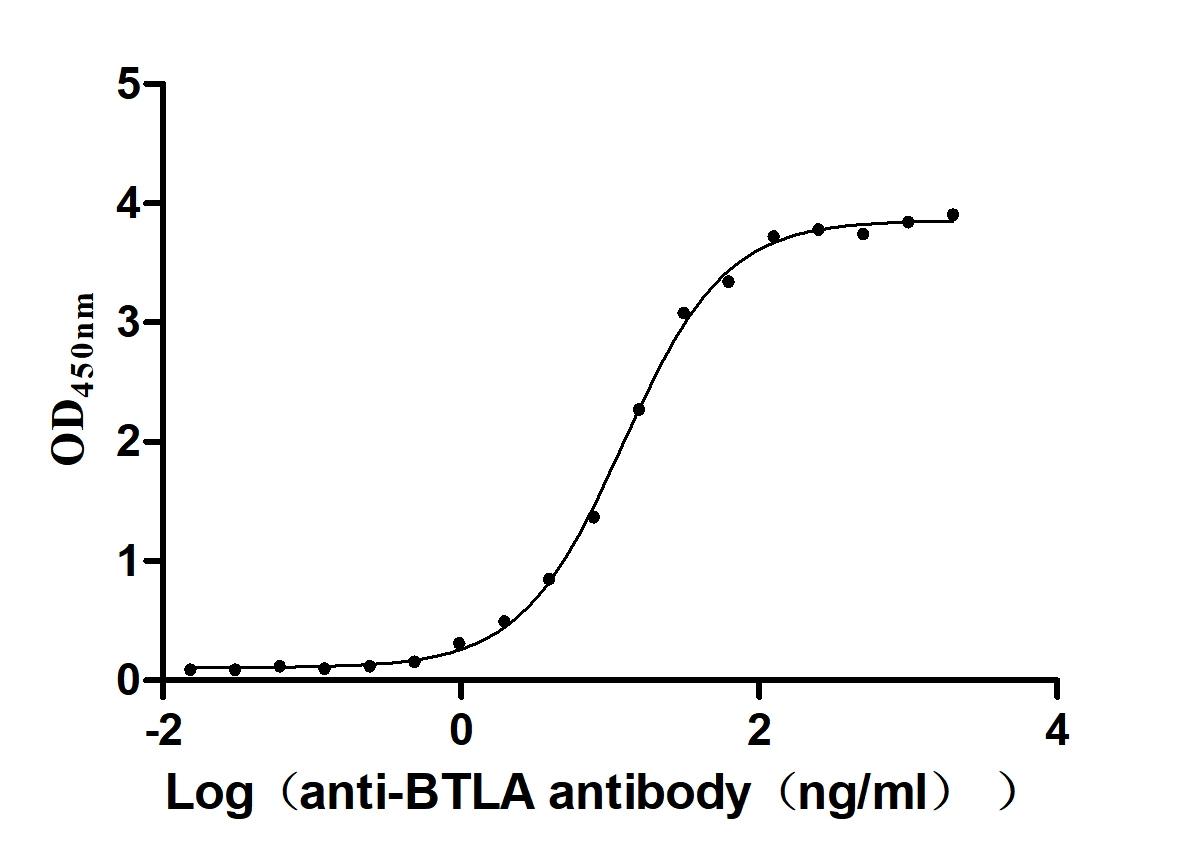Recombinant Human Heat-stable enterotoxin receptor (GUCY2C), partial (Active)
In Stock Promotion-
中文名稱:人GUCY2C重組蛋白
-
貨號:CSB-MP010053HU
-
規(guī)格:¥1368
-
促銷:
-
圖片:
-
(Tris-Glycine gel) Discontinuous SDS-PAGE (reduced) with 5% enrichment gel and 15% separation gel.
-
Activity
Measured by its binding ability in a functional ELISA. Immobilized human GUCY2C at 5 μg/ml can bind Anti-GUCY2C recombinant antibody (CSB-RA010053A2HU), the EC50 is 11.89-24.13 ng/mL. Biological Activity Assay
-
-
其他:
產(chǎn)品詳情
-
純度:Greater than 95% as determined by SDS-PAGE.
-
內(nèi)毒素:Less than 1.0 EU/ug as determined by LAL method.
-
生物活性:Measured by its binding ability in a functional ELISA. Immobilized human GUCY2C at 5 μg/mL can bind Anti-GUCY2C recombinant antibody (CSB-RA010053A2HU), the EC50 is 11.89-24.13 ng/mL.
-
基因名:
-
Uniprot No.:
-
別名:(STA receptor)(hSTAR)(Guanylyl cyclase C)(GC-C)(Intestinal guanylate cyclase)
-
分子結(jié)構(gòu):
-
種屬:Homo sapiens (Human)
-
蛋白長度:Partial
-
來源:Mammalian cell
-
分子量:49.6 kDa
-
表達(dá)區(qū)域:24-430aa
-
氨基酸序列SQVSQNCHNGSYEISVLMMGNSAFAEPLKNLEDAVNEGLEIVRGRLQNAGLNVTVNATFMYSDGLIHNSGDCRSSTCEGLDLLRKISNAQRMGCVLIGPSCTYSTFQMYLDTELSYPMISAGSFGLSCDYKETLTRLMSPARKLMYFLVNFWKTNDLPFKTYSWSTSYVYKNGTETEDCFWYLNALEASVSYFSHELGFKVVLRQDKEFQDILMDHNRKSNVIIMCGGPEFLYKLKGDRAVAEDIVIILVDLFNDQYFEDNVTAPDYMKNVLVLTLSPGNSLLNSSFSRNLSPTKRDFALAYLNGILLFGHMLKIFLENGENITTPKFAHAFRNLTFEGYDGPVTLDDWGDVDSTMVLLYTSVDTKKYKVLLTYDTHVNKTYPVDMSPTFTWKNSKLPNDITGRGPQ
-
蛋白標(biāo)簽:N-terminal 10xHis-tagged
-
產(chǎn)品提供形式:Lyophilized powder
Note: We will preferentially ship the format that we have in stock, however, if you have any special requirement for the format, please remark your requirement when placing the order, we will prepare according to your demand. -
緩沖液:Lyophilized from a 0.2 μm filtered 20 mM Tris-HCl, 0.5 M NaCl, 6% Trehalose, pH 8.0
-
復(fù)溶:We recommend that this vial be briefly centrifuged prior to opening to bring the contents to the bottom. Please reconstitute protein in deionized sterile water to a concentration of 0.1-1.0 mg/mL.We recommend to add 5-50% of glycerol (final concentration) and aliquot for long-term storage at -20°C/-80°C. Our default final concentration of glycerol is 50%. Customers could use it as reference.
-
儲存條件:Store at -20°C/-80°C upon receipt, aliquoting is necessary for mutiple use. Avoid repeated freeze-thaw cycles.
-
保質(zhì)期:The shelf life is related to many factors, storage state, buffer ingredients, storage temperature and the stability of the protein itself.
Generally, the shelf life of liquid form is 6 months at -20°C/-80°C. The shelf life of lyophilized form is 12 months at -20°C/-80°C. -
貨期:3-7 business days
-
注意事項:Repeated freezing and thawing is not recommended. Store working aliquots at 4°C for up to one week.
-
產(chǎn)品描述:
Recombinant human GUCY2C protein (24-430 AA) was fused to a 10xHis-tag at the N-terminus and expressed in the mammalian cells. This GUCY2C protein is characterized by high purity (>95%, SDS-PAGE), low endotoxin content (<1.0 EU/ug of the protein, LAL method), and biological activity. Its activity has been validated by binding to the anti-GUCY2C recombinant antibody in a functional ELISA, with the EC50 of 11.89-24.13 ng/mL. The GUCY2C protein has a calculated molecular weight of 49.6 kDa. It migrates as 60-90 kDa under reducing conditions (SDS-PAGE) due to glycosylation. And it is available now.
GUCY2C, an intestine-specific expressed transmembrane protein, participates in regulating intestinal function and Na+ dynamic balance, and promoting food digestion and absorption after being activated by STa, guanosine, and uroguanosine. GUCY2C is considered a colorectal cancer-specific antigen due to its high intestinal tissue specificity. To date, the GUCY2C protein has been used in vaccines, immunotoxins, and CAR-T cells, among other immunotherapies. Some trials have achieved good clinical results. The development and research of GUCY2C recombinant protein can promote and push the development of vaccines and treatment of GUCY2C-expressing tumors of the intestine.
-
Datasheet & COA:Please contact us to get it.
相關(guān)產(chǎn)品
靶點詳情
-
功能:Receptor for the E.coli heat-stable enterotoxin (E.coli enterotoxin markedly stimulates the accumulation of cGMP in mammalian cells expressing GC-C). Also activated by the endogenous peptides guanylin and uroguanylin.
-
基因功能參考文獻(xiàn):
- High Expressions of guanylyl cyclase C is associated with rectal cancer. PMID: 28418917
- The findings support that the activating mutation in GUCY2C creates an intestinal environment with a major influence on the microbiota, which could contribute to the increased susceptibility to inflammatory bowel disease in patients with Familial GUCY2C diarrhea syndrome. PMID: 28902124
- the expression of GCC is maintained throughout the process of tumor progression and formation of metastatic disease. PMID: 29261789
- To investigate gut motility and hormones before and after a meal in Familial GUCY2C diarrhea syndrome patients and compare with healthy controls PMID: 28957388
- Mutations in GUCY2C indicate a role for this receptor in the pathogenesis of sporadic Congenital secretory diarrhea. PMID: 25994218
- these data support Ad5-GUCY2C-PADRE as a safe and effective vaccination strategy in preclinical models and position Ad5-GUCY2C-PADRE for Phase I clinical testing in colorectal cancer patients. PMID: 27903079
- Familial GUCY2C diarrhoea syndrome is caused by an activating mutation in the GUCY2C gene, which causes impaired contractility and fluid stagnation in the small bowel PMID: 27338166
- Findings show how caloric suppression of the guanylin-GUCY2C signaling axis links obesity to negation of a universal tumor suppressor pathway in colorectal cancer. PMID: 26773096
- Data show that individuals affected with meconium ileus (MI) had either homozygous or compound heterozygous variants in enterotoxin receptor GUCY2C. PMID: 25370039
- High guanylyl cyclase C expression is associated with colon cancer recurrence. PMID: 24919572
- Transmission disequilibrium tests (TDT), case-control studies and quantitative analyses indicated association between GUC2C with Attention-deficit/hyperactivitydisorder and its core symptoms. PMID: 25064385
- Intestinal cell proliferation and senescence are regulated by receptor guanylyl cyclase C and p21. PMID: 24217248
- GUCY2C signaling constitutes a direct link between the initiation of colorectal cancer and the induction of its associated desmoplastic stromal niche. PMID: 24085786
- Data show that lower survival (OS) and disease-free survival (DFS) rates were significantly associated with guanylate cyclase C (GCC) and CK20 mRNA levels. PMID: 23150200
- Interaction with VIP36 is dependent on glycosylation at the same sites that allow GC-C to fold and bind ligand. PMID: 23269669
- GUCY2C opposes systemic genotoxic tumorigenesis by regulating AKT-dependent intestinal barrier integrity PMID: 22384056
- Mutations in GUCY2C were associated with the Meconium ileus phenotype. downregulation of GUCY2C leads to a cystic fibrosis-like intestinal phenotype. PMID: 22521417
- We identified a heterozygous missense mutation (c.2519G-->T) in GUCY2C in all family members with familial diarrhea syndrome. PMID: 22436048
- High guanylyl cyclase C is associated with colon cancer. PMID: 21533822
- Data suggest that monitoring the peripheral blood GCC expressions may allow employing different treatment options to metastatic CRC patients. PMID: 21901559
- Lymph nodes (range: 2-159) from 291 prospectively enrolled node-negative colorectal cancer patients were analyzed by histopathology and GUCY2C quantitative RT-PCR. PMID: 21307149
- Longer survival was associated with hypomethylation at specific CpG sites (e.g. GREB1, TGIF and TOB1) and hypermethylation in other genes (e.g. TMCO5, PTPRN and GUCY2C). PMID: 21577013
- A novel PDZ protein regulates the activity of guanylyl cyclase C, the heat-stable enterotoxin receptor. PMID: 11950846
- guanylyl cyclase c is ectopically expressed in primary and metastatis adenocarcinoma of the esophagus and stomach PMID: 12163327
- SH3 domain -mediated protein-protein interaction with the catalytic domain of guanylyl cyclase C inhibited the cyclase activity and might be pivotal for the desensitization phenomenon of the guanylyl cyclase C receptor PMID: 12649275
- gelatinolytic activity of GCC in colorectal tumor tissues may facilitate the hepatic metastatic process in the steps after intravasation but not during or before intravasation PMID: 14581363
- a novel role for glycosidic modification of GC-C during its biosynthesis, in imparting subtle conformational changes in the receptor that allow for ligand-mediated activation and perhaps regulation of basal activity PMID: 14748740
- Lack of guanylyl cyclase c expression assoeciated with significant reduction in adenomas in Apc(Min/+);Gucy2c(-/-) mice PMID: 15825168
- Transformation associated with reflux at the gastroesophageal junction reflects activation by bile acid and acid of a transcriptional program involving NF-kappaB and Cdx2, which mediate intestinal metaplasia and ectopic expression of GC-C. PMID: 16618413
- This validated assay is being applied to approximately 10,000 lymph nodes in a prospective trial to define the sensitivity of Guanylyl cyclase C(GCC) qRT-PCR for staging patients with colorectal cancer. PMID: 16899600
- docking of the c-src SH2 domain to phosphorylated GC-C results in colocalization and further activation of c-src. PMID: 19620276
- the role of the linker region in receptor guanylyl cyclases PMID: 19648115
- GCC is a specific marker for differentiating primary and secondary metatstatic ovarian mucinous neoplasms. PMID: 19694825
- Results suggest that GUCY2C quantitative reverse transcriptase (qRT)-PCR can be used to detect occult lymph node metastases in pN0 colorectal cancer patients. PMID: 19895223
- Expression of the receptor guanylyl cyclase C and its ligands in reproductive tissues of the rat: a potential role for a novel signaling pathway in the epididymis. PMID: 12444076
- The protein kinase-like domain in receptor guanylyl cyclase C provides a critical structural link between the extracellular domain and the catalytic domain in regulation of this family of receptors. PMID: 11478887
顯示更多
收起更多
-
相關(guān)疾病:Diarrhea 6 (DIAR6); Meconium ileus (MECIL)
-
亞細(xì)胞定位:Cell membrane; Single-pass type I membrane protein. Endoplasmic reticulum membrane; Single-pass type I membrane protein. Note=The 145 kDa plasma membrane form of GC-C contains sialic acid and galactose residues, while a differencially glycosylated 130 Kda form is a high mannose form that is resident in the endoplasmic reticulum and may serve as the precursor for the cell surface form.
-
蛋白家族:Adenylyl cyclase class-4/guanylyl cyclase family
-
數(shù)據(jù)庫鏈接:
Most popular with customers
-
Recombinant Human T-cell antigen CD7 (CD7), partial (Active)
Express system: Mammalian cell
Species: Homo sapiens (Human)
-
Recombinant Mouse Microtubule-associated protein tau (Mapt) (Active)
Express system: Mammalian cell
Species: Mus musculus (Mouse)
-
Recombinant Human V-set and immunoglobulin domain-containing protein 4 (VSIG4), partial (Active)
Express system: Mammalian cell
Species: Homo sapiens (Human)
-
Recombinant Human CD81 antigen (CD81), partial (Active)
Express system: Mammalian cell
Species: Homo sapiens (Human)
-
Recombinant Human Cytotoxic and regulatory T-cell molecule (CRTAM), partial (Active)
Express system: Mammalian cell
Species: Homo sapiens (Human)
-
Recombinant Mouse Cytotoxic and regulatory T-cell molecule (Crtam), partial (Active)
Express system: Mammalian cell
Species: Mus musculus (Mouse)
-
Recombinant Human B- and T-lymphocyte attenuator(BTLA), partial (Active)
Express system: Mammalian cell
Species: Homo sapiens (Human)























